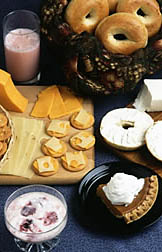Read the
magazine
story to find out more.
|
| 
Food choices have a big impact on the amount of
saturated fat in your diet. A croissant, which has about the same number of
calories as a bagel, has 32 times as much saturated fat. Click the image for
more information about it.
|

|
Facts on Fats Could Prompt Healthier Eating
By Rosalie Marion
Bliss
March 11, 2008 The 2005 Dietary Guidelines for
Americans included—for the first time—recommendations that U.S.
consumers keep their intake of trans fatty acids as low as possible. Landmark
research conducted by scientists at the Beltsville Human Nutrition Research
Center (BHNRC),
Beltsville, Md., contributed to that conclusion. The BHNRC is part of the
Agricultural Research Service (ARS), the
U.S. Department of Agriculture's chief
scientific research agency.
In the early ARS study, 58 adult volunteers were fed four different
controlled diets, described as moderately high trans fat, high trans fat, high
saturated fat, and high “heart healthy” oleic acid.
LDL "bad" cholesterol levels were measured each time the male and
female volunteers completed a diet for a 6-week period. The study showed that
after the volunteers consumed any of the trans-fat or saturated-fat
diets—as opposed to the oleic acid diet—their LDL cholesterol levels
were significantly increased.
The scientists also reported that it’s important not to replace dietary
trans fats with saturated fats. The dietary guidelines now recommend consuming
less than 10 percent of daily calories from saturated fatty acids; that's 22
grams or less for a 2,000-calorie diet. But a 2007 ARS data analysis shows that
about 64 percent of adults exceed this recommendation.
The BHNRC researchers studied the levels and sources of saturated fat and
unsaturated fats in the American diet. The analysis was based on nationally
representative dietary-intake survey data from What We Eat in America/NHANES
2003-2004. The research was led by nutritionist
Alanna
J. Moshfegh, who heads the BHNRC
Food
Surveys Research Group.
Read
more about this research in the March 2008 issue of Agricultural
Research magazine.